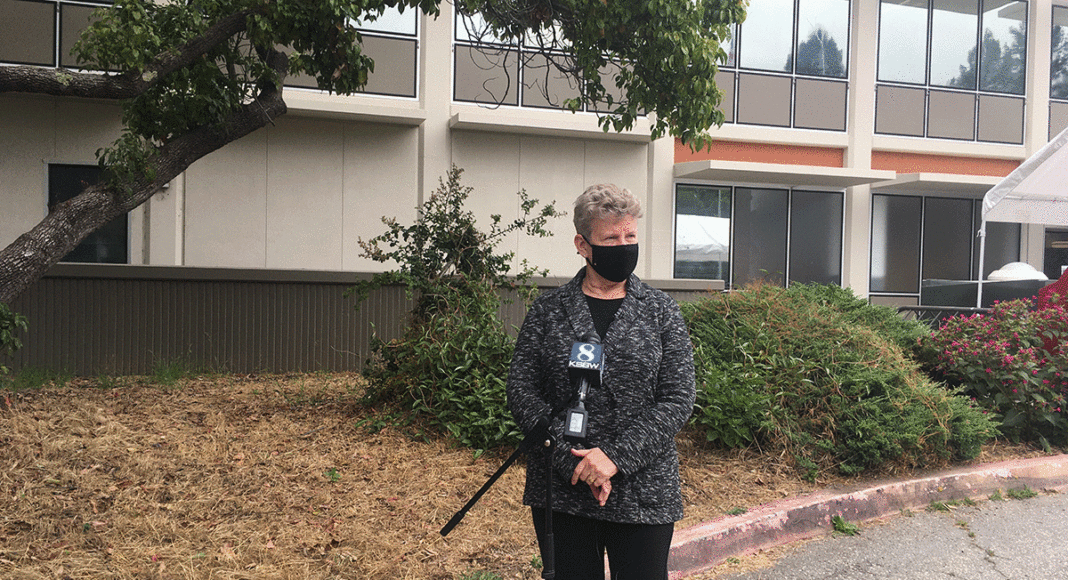Due to exponential growth in the rate of Covid-19 cases locally, Santa Cruz County health leaders expect many businesses to cease indoor operations as early as next week.
According to the most recent data entered by county officials Wednesday, the county has had 878 confirmed Covid-19 cases. Of those, 531 are currently active—well above the 343 patients who have recovered from the disease.
“That is a dramatic change for the county of Santa Cruz,” Public Health Officer Dr. Gail Newel said in a press conference Thursday.
Four months into the pandemic, 65 patients locally have required hospitalization. The county announced Thursday that a fourth patient had died with the virus being a contributing factor to his death. The man was in his 70s, and he was hospitalized with cardiac issues. He tested positive for Covid-19 upon admission. Newel said investigators presume that the patient contracted the coronavirus from someone in his household, as members of his household have tested positive for Covid-19.
The California Department of Public Health has now flagged Santa Cruz County, due its growing case count.
The details of what happens following that are complicated—involving various state and local triggers, two concurrent multi-day waiting periods, and a collaborative process to draft new health orders. The upshot, however, is that many businesses will likely have to shift their operations to being outdoors in the next two weeks or else close down again. That list of operations includes gyms, offices for non-essential sectors, nail salons, body waxing studios, tattoo parlors, hair salons, barbershops, malls, and religious and cultural ceremonies, like weddings and funeral services.
Mimi Hall, director of the Santa Cruz County Health Services Agency, said testing has confirmed Covid-19 cases among the elderly or staff at five of the county’s seven skilled-nursing facilities, but none of those facilities have seen any deaths from the disease.
WITHOUT A TRACE?
For a variety of reasons, contact tracers are having a difficult time keeping up with the burgeoning caseload.
On Thursday, Hall announced a new part of the HSA’s website to help companies expedite the contact tracing process. Oftentimes, the first person a patient will tell about their positive test result is their boss. As a result, employers often find out about a new Covid-19 case well before the county does. Now, companies will be able to take action immediately by implementing the proper protocols and notifying the county health officials.
Two months after the county laid out its contact tracing plan, Hall also outlined reasons behind some of the delays the county has experienced in onboarding new contact tracers.
Each contact tracer needs to go through a 20-hour state training that typically takes a full week to complete, she said. Additionally, contact tracers are learning a new platform called Cal Connect, where they have to input their data, Hall said.
“And contact tracers don’t work on their own,” she added.
They work as a team with investigators and nurses. Hall noted that the countywide mandatory furloughs—cutting employee pay between 7.5-10%—do apply to HSA staff.
“We’re not exempt as public health workers,” she said. “So we’ve been trying to balance, how do we do coverage and furloughs and work on a skeleton crew? There are a lot of pressures on the staffing complexities that impact us.”
The county has also seen delays in testing, with results coming back very slowly—often due to a shortage of testing reagents, some of the chemicals needed to run tests. The delay makes it difficult for contact tracers to act on new cases in a timely manner.
Partly as an effort to remedy that, the county is partnering with UCSC and infusing the school with $1 million in local Coronavirus Aid, Relief, and Economic Security (CARES) Act in order to boost researchers’ testing capacity there, Hall said. UCSC does have enough of those testing reagents right now, Newel said.
Deputy Health Officer Dr. David Ghilarducci said one of the biggest bottlenecks the county is currently experiencing is with remdesivir, a drug used to treat Covid-19. Santa Cruz County officials have been buying the maximum amount they are allowed to purchase and distributing it to hospitals, he said.
Supplies of personal protective equipment are relatively strong right now, Ghilarducci added.
OUT OF THE QUESTION
Last week, Newel told reporters she thought that, given the rise of cases among young adults, it was possible that the protests in June and July contributed to the surge in disease rates. Thursday, Newel said that doesn’t appear to be the case, according to the contact tracing her colleagues have been doing.
“That seems to not be playing out in our case investigations,” she said, elaborating that more informal gatherings are often the culprit behind the spread. “It continues to seem to be gatherings over a long period of time with close contacts, gatherings with friends in backyards. Not so much the outdoor marching, movement activities.”
One takeaway, as pointed out by county spokesperson Jason Hoppin, is that outdoor activities are apparently much safer than indoor ones.
Newel said she and other HSA officials were worried when they saw how crowded last month’s memorial for a slain sheriff’s sergeant was—with many deputies in attendance not wearing face coverings.
“We have not identified a single case, at this point, related to the memorial,” Newel said.














